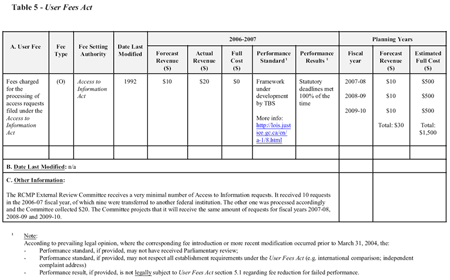Common menu bar links
Breadcrumb Trail
ARCHIVED - RCMP External Review Committee
 This page has been archived.
This page has been archived.
Archived Content
Information identified as archived on the Web is for reference, research or recordkeeping purposes. It has not been altered or updated after the date of archiving. Web pages that are archived on the Web are not subject to the Government of Canada Web Standards. As per the Communications Policy of the Government of Canada, you can request alternate formats on the "Contact Us" page.
SECTION III: SUPPLEMENTARY INFORMATION
Organizational Information
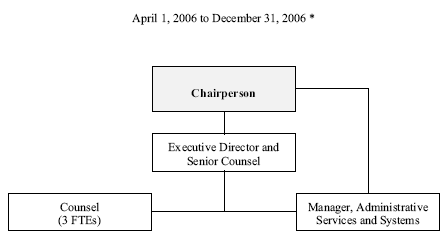
* From August 4, 2006 to March 31, 2007 one position was vacant. Until January 2007, our initial FTE planned was 6. Funding was received, effective January 2007 for 3 additional backlog resources (one for a two year term and two for a five year term). Three positions could not be filled in this fiscal year.
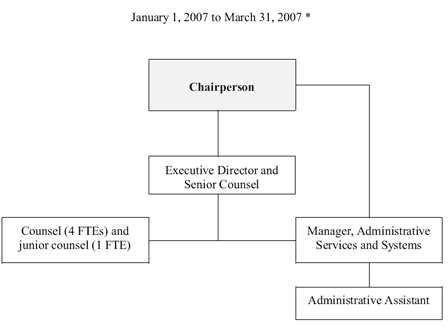
* From August 4, 2006 to March 31, 2007 one position was vacant. Until January 2007, our initial FTE planned was 6. Funding was received, effective January 2007 for 3 additional backlog resources (one for a two year term and two for a five year term). Three positions could not be filled in this fiscal year.
| ($ thousands) | 2004-05 Actual | 2005-06 Actual | 2006-2007 | |||
|---|---|---|---|---|---|---|
| Main Estimates | Planned Spending | Total Authorities | Total Actuals | |||
| Independent, timely, fair and impartial case review leading to the provision of quality findings and recommendations in all cases referred to the Committee | 698 | 733 | 669 | 669 | 779 | 778 |
| Dissemination of information on the role of the Committee and its findings and recommendations, as well as on relevant legal principles | 175 | 183 | 226 | 226 | 195 | 131 |
| Total | 873 | 916 | 895 | 895 | 974 | 909 |
| Less: Non-respendable revenue | 0 | 0 | 0 | 0 | 0 | 0 |
| Plus: Cost of services received without charge* | 116 | 118 | 138 | 138 | 138 | 139 |
| Total Departmental Spending | 989 | 1034 | 1033 | 1033 | 1112 | 1048 |
| Full Time Equivalents | 6 | 6 | 6 | 9 | 9 | 6** |
* Services received without charge usually include accommodation provided by PWGSC, the employer’s share of employees’ insurance premiums, and expenditures paid by TBS (excluding revolving funds), Workers’ Compensation coverage provided by Social Development Canada, and services received from the Department of Justice Canada (see Table 4).
** From August 4, 2006 to March 31, 2007 one position was vacant. Until January 2007, our initial FTE planned was 6. Funding was received, effective January 2007 for 3 additional backlog resources (one for a two year term and two for a five year term). Three positions could not be filled in this fiscal year.
| 2006–07 | ||||
|---|---|---|---|---|
| Program Activity | Budgetary ($ thousands) | Total | ||
| Operating | Total: Gross Budgetary Expenditures |
Less: Respendable Revenue |
||
| Independent, timely, fair and impartial case review leading to the provision of quality findings and recommendations in all cases referred to the Committee | ||||
| Main Estimates | 669 | 669 | 0 | 669 |
| Planned Spending | 669 | 669 | 0 | 669 |
| Total Authorities | 779 | 779 | 0 | 779 |
| Actual Spending | 778 | 778 | 0 | 778 |
| Dissemination of information on the role of the Committee and its findings and recommendations, as well as on relevant legal principles | ||||
| Main Estimates | 226 | 226 | 0 | 226 |
| Planned Spending | 226 | 226 | 0 | 226 |
| Total Authorities | 195 | 195 | 0 | 195 |
| Actual Spending | 131 | 131 | 0 | 131 |
| ($ thousands) | |||||
| Vote or Statutory Item | Truncated Vote or Statutory Wording | 2006-2007 | |||
|---|---|---|---|---|---|
| Main Estimates |
Planned Spending |
Total Authorities |
Total Actuals |
||
| 75 | Operating Expenditures | 790 | 790 | 880 | 815 |
| (S) | Contributions to employee benefit plans | 105 | 105 | 105 | 94 |
| Total | 895 | 895 | 985 | 909 | |
| ($ thousands) | 2006-07 Actual Spending |
|---|---|
| Accommodation provided by Public Works and Government Services Canada | 96 |
|
Contributions covering employer’s share of employees’ insurance premiums and expenditures paid by Treasury Board of Canada Secretariat (excluding revolving funds); employer’s contribution to employees’ insured benefit plans and associated expenditures paid by Treasury Board of Canada Secretariat |
43 |
|
Salary and associated expenditures of legal services provided by the Department of Justice Canada |
0 |
|
Total 2006-2007 Services received without charge |
139 |
Table 6 - Financial Statements
Statement of Management Responsibility (unaudited)
Responsibility for the integrity and objectivity of the accompanying financial statements for the year ended March 31, 2007 and all information contained in these statements rests with departmental management. These financial statements have been prepared by management in accordance with Treasury Board accounting policies which are consistent with Canadian generally accepted accounting principles for the public sector.
Management is responsible for the integrity and objectivity of the information in these financial statements. Some of the information in the financial statements is based on management's best estimates and judgment and gives due consideration to materiality. To fulfill its accounting and reporting responsibilities, management maintains a set of accounts that provides a centralized record of the department's financial transactions. Financial information submitted to the Public Accounts of Canada and included in the Committee's Departmental Performance Report is consistent with these financial statements.
Management maintains a system of financial management and internal control designed to provide reasonable assurance that financial information is reliable, that assets are safeguarded and that transactions are in accordance with the Financial Administration Act, are executed in accordance with prescribed regulations, within Parliamentary authorities, and are properly recorded to maintain accountability of Government funds. Management also seeks to ensure the objectivity and integrity of data in its financial statements by careful selection, training and development of qualified staff, by organizational arrangements that provide appropriate divisions of responsibility, and by communication programs aimed at ensuring that regulations, policies, standards and managerial authorities are understood throughout the Committee.
The financial statements of the Committee have not been audited.

Statement of Financial Position (unaudited)
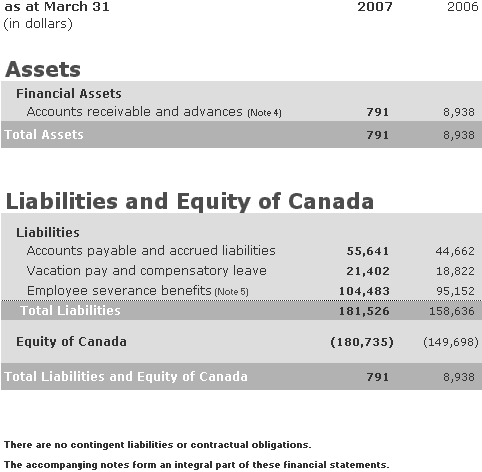
Statement of Equity (unaudited)
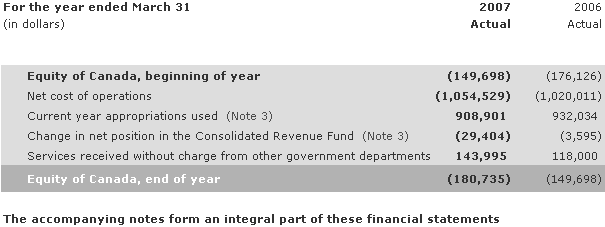
Statement of Operations (unaudited)
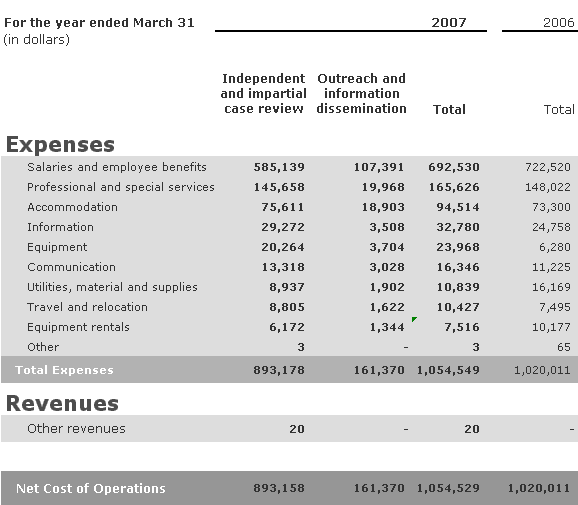
Statement of Cash Flow (unaudited)
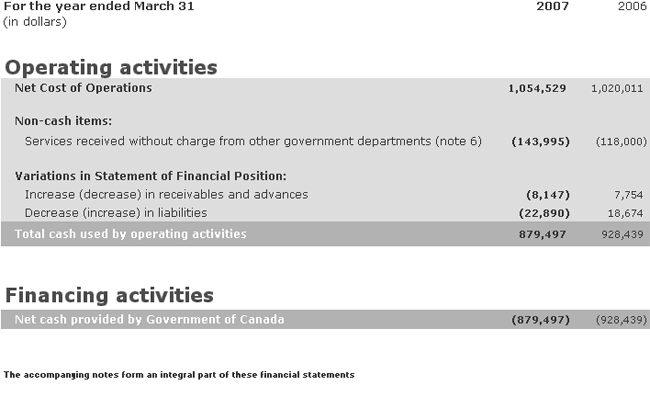
Notes to the Financial Statements (unaudited)
1. Authority and Objectives
Under the RCMP Act, the RCMP Commissioner refers all appeals of formal discipline and all discharge and demotion appeals to the Committee unless the member of the RCMP requests that the matter not be referred. In addition, pursuant to section 33 of the RCMP Act, the RCMP Commissioner refers certain types of grievances to the Committee in accordance with regulations made by the Governor in Council. Section 36 of the RCMP Regulations specifies the grievances which the RCMP Commissioner is obliged to refer to the Committee, namely grievances respecting:
i) the Force's interpretation and application of government policies that apply to government departments and that have been made to apply to members;
ii) the stoppage of pay and allowances of members made pursuant to subsection 22(3) of the RCMP Act;
iii) the Force's interpretation and application of the Isolated Posts Directive;
iv) the Force's interpretation and application of the RCMP Relocation Directive; and
v) administrative discharge on the grounds of physical or mental disability, abandonment of post, or irregular appointment.
The Committee is also responsible for outreach and information dissemination.
2. Significant accounting policies
The financial statements have been prepared in accordance with Treasury Board accounting policies which are consistent with Canadian generally accepted accounting principles for the public sector.
Significant accounting policies are as follows:
(a) Parliamentary appropriations
The Committee is financed by the Government of Canada through Parliamentary appropriations. Appropriations provided to the Committee do not parallel financial reporting according to generally accepted accounting principles since appropriations are primarily based on cash flow requirements. Consequently, items recognized in the statement of operations and the statement of financial position are
not necessarily the same as those provided through appropriations from Parliament. Note 3 provides a high-level reconciliation between the bases of reporting.
(b) Net Cash Provided by Government
The Committee operates within the Consolidated Revenue Fund (CRF), which is administered by the Receiver General for Canada. All cash received by the Committee is deposited to the CRF and all cash disbursements made by the Committee are paid from the CRF. The net cash provided by Government is the difference between all cash receipts and all cash disbursements including transactions between
departments of the federal government.
(c) Change in net position in the Consolidated Revenue Fund
The change in net position in the Consolidated Revenue Fund is the difference between the net cash provided by Government and appropriations used in a year, excluding the amount of non respendable revenue recorded by the Committee. It results from timing differences between when a transaction affects
appropriations and when it is processed through the CRF.
(d) Revenues
Revenues are accounted for in the period in which the underlying transaction or event occurred that gave rise to the revenues. Revenues include access to information program (ATIP) fees, employees' parking fees etc.
(e) Expenses
Expenses are recorded on the accrual basis:
i) Vacation pay and compensatory leave are expensed as the benefits accrue to employees under their respective terms of employment.
ii) Services provided without charge by other government departments for accommodation and the employer's contribution to the health and dental insurance plans are recorded as operating expenses at their estimated cost.
(f) Employee future benefits
Pension benefits: Eligible employees participate in the Public Service Pension Plan, a multiemployer administered by the Government of Canada. The Committee's contributions to the Plan are charged to expenses in the year incurred and represent the total obligation to the Plan. Current legislation does not require the Committee to make contributions for any actuarial deficiencies of the Plan.
Severance benefits: Employees are entitled to severance benefits under labour contracts or conditions of employment. These benefits are accrued as employees render the services necessary to earn them. The obligation relating to the benefits earned by employees is calculated using information derived from the results of the actuarially determined liability for employee severance benefits for the Government as a whole.
(g) Receivables
Accounts receivables are stated at amounts expected to be ultimately realized; a provision is made for receivables where recovery is considered uncertain.
(h) Measurement uncertainty
The preparation of these financial statements in accordance with Treasury Board accounting policies, which are consistent with Canadian generally accepted accounting principles for the public sector, requires management to make estimates and assumptions that affect the reported amounts of assets, liabilities, revenues and expenses reported in the financial statements. At the time of preparation
of these statements, management believes the estimates and assumptions to be reasonable. The most significant item where an estimate is used is the liability for employee severance benefits. Actual results could significantly differ from those estimated. Management's estimates are reviewed periodically and, as adjustments become necessary, they are recorded in the financial statements in the year
they become known.
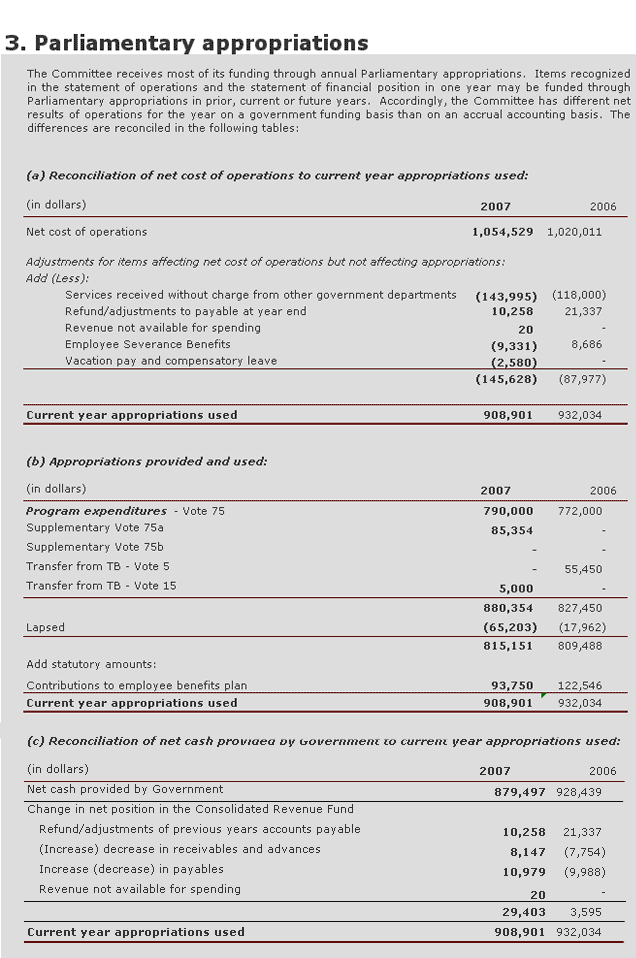

5. Employee Benefits
(a) Pension benefits
The Committee's employees participate in the Public Service Pension Plan, which is sponsored and administered by the Government of Canada. Pension benefits accrue up to a maximum period of 35 years at a rate of 2 percent per year of pensionable service, times the average of the best five consecutive years of earnings. The benefits are integrated with Canada/Qu�bec Pension Plans benefits and they
are indexed to inflation.
Both the employees and the Committee contribute to the cost of the Plan. The 2006-07 expense amounts to $69,093 ($90,684 in 2005-06), which represents approximately 2.2 times (2.6 in 2005-06) the contributions by employees.
The Committee's responsibility with regard to the Plan is limited to its contributions. Actuarial surpluses or deficiencies are recognized in the financial statements of the Government of Canada, as the Plan's sponsor.
(b) Severance benefits
The Committee provides severance benefits to its employees based on eligibility, years of service and final salary. The accrued benefit obligation at the end of the year is calculated by multiplying a ratio (23.20% for 2006 and 23.64% for 2007) to the Committee's annual gross payroll at year end subject to severance pay, which is the payroll related to indeterminate employees. The ratios are
determined by Treasury Board Secretariat. These severance benefits are not pre-funded. Benefits will be paid from future appropriations. Information about the severance benefits, measured as at March 31, is as follows:
| (in dollars) |
2007
|
2006
|
|---|---|---|
| Accrued benefit obligation, beginning of year | 95,152 | 103,838 |
| Expense for the year | 9,331 | (8,686) |
| Accrued benefit obligation, end of year | 104,483 | 95,152 |
6. Related party transactions
The Committee is related as a result of common ownership to all Government of Canada departments, agencies, and Crown corporations. The Committee enters into transactions with these entities in the normal course of business and on normal trade terms. Also, during the year, the Committee received services which were obtained without charge from other Government departments as presented in part (a).
(a) Services received without charge from other government departments
During the year the Committee received service without charge from other departments. These services have been recognized in the Committee's Statement of Operations as follows:
| (in dollars) |
2007
|
2006
|
|---|---|---|
| Accommodation | 94,514 | 73,000 |
| Employer's contribution to the health and dental insurance plans | 49,481 | 45,000 |
| Total | 143,995 | 118,000 |
The Government has structured some of its administrative activities for efficiency and cost-effectiveness purposes so that one department performs these on behalf of all without charge. The costs of these services, which include payroll and cheque issuance services provided by Public Works and Government Services Canada and audit services provided by the Office of the Auditor General, are not included as an expense in the Committee's Statement of Operations.
| (in dollars) |
2007
|
2006
|
|---|---|---|
| Accounts receivable with other government departments and agencies | 541 | 6,190 |
| Accounts payable to other government departments and agencies | 5,377 | 8,688 |
7. Comparative information
Comparative figures have been restated to conform to the current year's presentation.
The services provided without charges included in the financial statements of fiscal year 2005-06 have been restated to reflect the actual costs. The effect is an increase in salaries and employee benefits, and accommodation costs on the statements of operations. The restatements are also reflected on the statements cash flow but do not affect the net cash provided by the government, the appropriation used or the equity balance.
Table 7 - Internal Audits or Evaluations
Internal Audits or Evaluations of the RCMP External Review Committee:
1. Participated in a One Pass Planning exercise with the Office of the Auditor General as part of the overall portfolio for Public Safety Canada in 2005-06. No further steps taken.
2. The Committee is in the process of an horizontal audit by the Office of the Auditor General as part of the ongoing Small Agencies horizontal audit. This audit was not finalized in this fiscal year.

